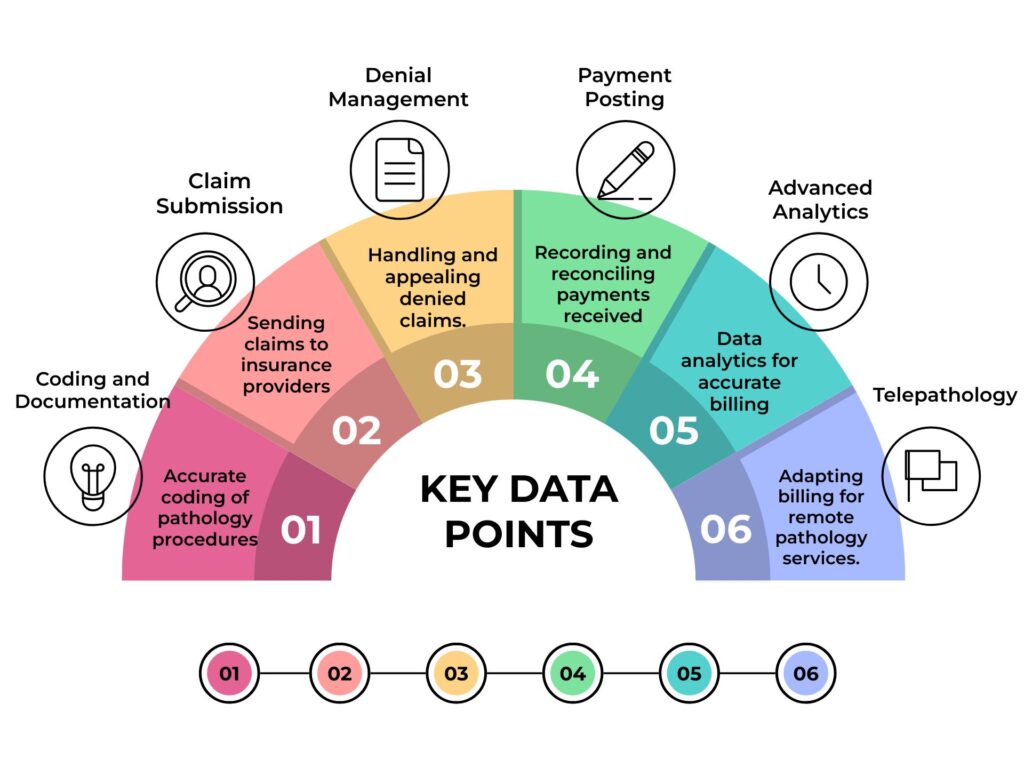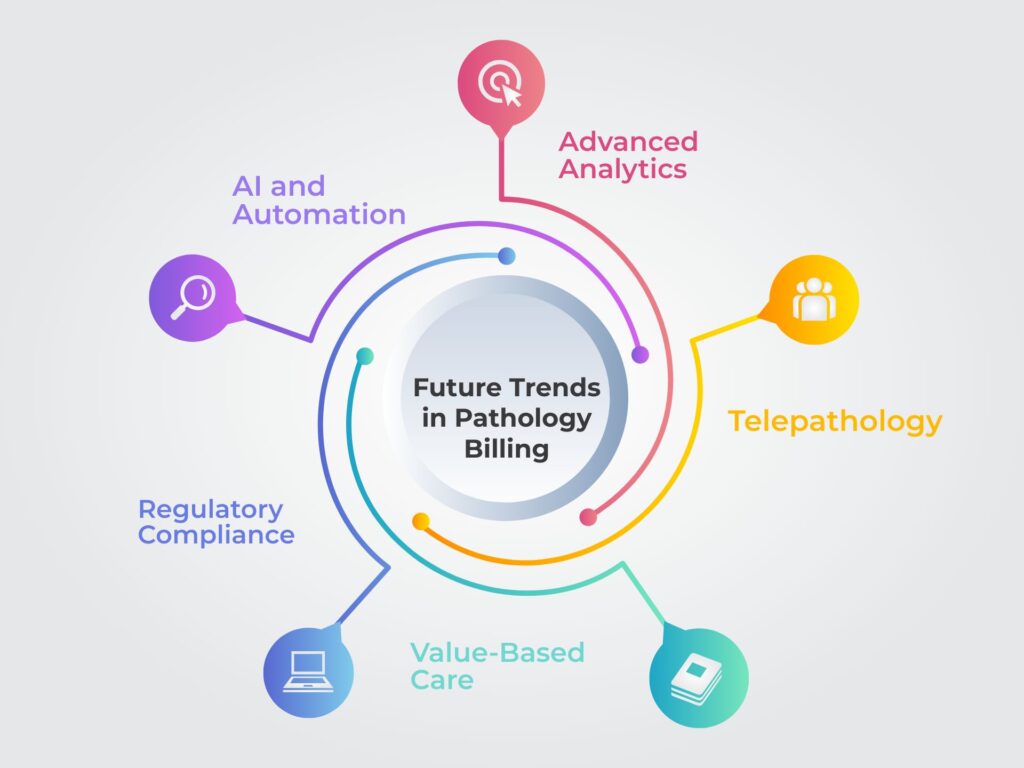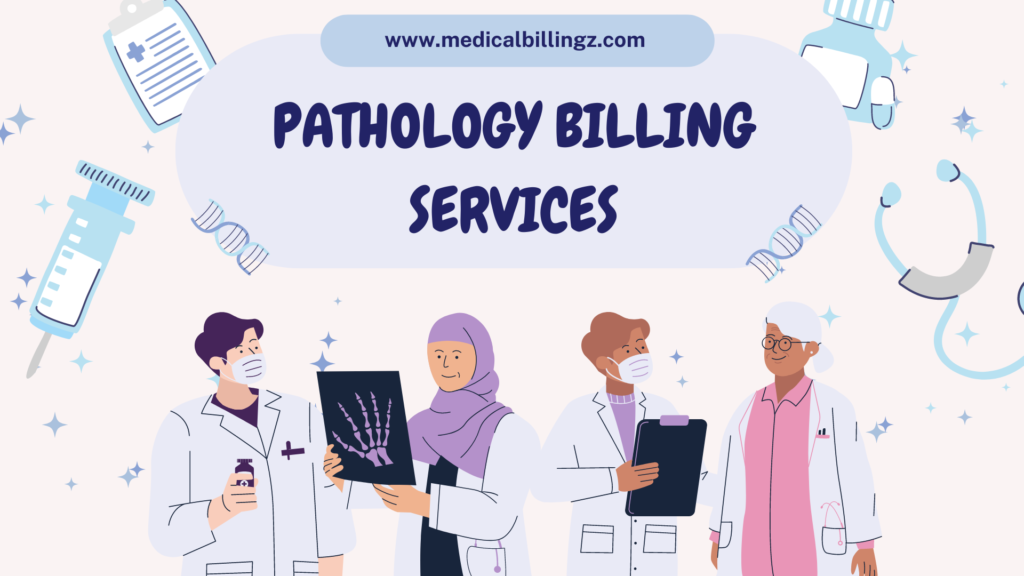Pathology Billing Services are essential to the healthcare sector because they guarantee that laboratory and diagnostic services are appropriately recorded and paid for. To optimize workflow and enhance financial results, pathologists, healthcare administrators, and billing specialists must comprehend these components.
What Are Pathology Billing Services?
Specialized procedures called Pathology Billing Services are meant to manage the financial side of the diagnostic services that pathologists offer. These services include testing and consultations related to pathology as well as the coding, billing, and payment collection.
Scope:
Pathology Billing Services entails submitting claims for laboratory testing, tissue analyses, and other diagnostic services carried out by pathologists to insurance providers and other payers. It also entails keeping track of patient accounts and making sure that billing laws are followed.
Services Covered Types:
- Histopathology: The study of tissue samples to make medical diagnoses.
- Cytopathology: The study of cell samples to identify diseases.
- Molecular pathology is the study of abnormalities of the genes and molecules.
Essential Elements of Pathology Billing Services
Understanding different elements, such as payer requirements, documentation requirements, and coding practices, is necessary for effective pathology billing.
Classification and Coding:
ICD-10 codes: These are used to list illnesses and diagnoses.
CPT codes: Indicate particular pathology services and treatments.
HCPCS Codes: Include extra supplies and services.

Record-keeping:
Complete and accurate documentation is necessary for correct invoicing. This comprises:
Patient History: Comprehensive details regarding the medical background of the patient.
Test Results: lucid summaries of diagnostic test results.
Medical Necessity: The rationale behind the conducted tests.
Payer Requirements:
Specific policies and requirements for billing are set forth by individual insurance providers. Knowing these specifications contributes to the accurate and timely processing of claims.
The Procedure for Pathology Billing Services
There are various steps involved in the pathology billing process, starting from the time a diagnostic service is rendered and ending with payment receipt.
Getting Ready for a Claim:
- Data collection: Compile insurance information, service codes, and patient data.
- Charge Entry: Enter the fees incurred in the billing system for the services provided.
Submission of Claim:
- Electronic Claims through Electronic Data Interchange (EDI) systems, the majority of claims are filed electronically.
- Though less frequent, paper claims are still utilized occasionally.
Settlement of Claims:
- After examining the claim, the payer decides how much has to be reimbursed.
- Denials and Rejections: Errors or non-compliance may result in the denial or rejection of a claim.
Looking for tips on improving transparency in patient billing?
Payment Posting:
- Remittance Advice: A record of the payer’s payment made.
- Patient billing: When the patient bears financial responsibility for the treatment.
Obstacles in Pathology Billing Services
Numerous obstacles that pathology billing services must overcome may have an effect on overall effectiveness and revenue cycle management.
- Difficult Coding: Billing mistakes and delays may result from the intricacy of pathology codes and the requirement for exact coding.
- Insurance Denials: Inadequate documentation, improper coding, or disregard for payer policies can all lead to denials.
- Regulatory Compliance: For billing professionals, it can be difficult to stay current on regulations that are changing and to ensure compliance.
- Data management: It can be difficult to accurately manage enormous amounts of data while also making sure that billing and documentation are accurate.
Best Practices and Solutions
The efficiency of Pathology Billing Services can be improved by employing cutting-edge solutions and best practices to address these issues.
Make Use of Advanced Billing Software: This new generation of billing software can increase accuracy, expedite claim submissions, and automate coding.
Frequent Education and Training: Up-to-date procedures are ensured by providing billing staff with ongoing education on payer policies, regulatory changes, and coding updates.
Establish Quality Assurance Procedures: Before claims are submitted, errors can be found and fixed with the aid of routine audits and quality checks.
Improve Communication with Payers: Having a good rapport with insurance providers can help to speed up the processing of claims and ensure that problems are resolved quickly.

Pathology Billing Services ‘ Future Trends
Pathology Billing Services are going through major changes in tandem with the ongoing evolution of the healthcare industry. Technological developments, changes in legal requirements, and changing patient expectations are what are causing these changes. It is imperative for pathology practices to comprehend these trends in order to maintain their competitiveness, guarantee compliance, and optimize revenue. Some major upcoming developments in pathology billing are listed below:
| Advantage Key Benefit |
| Efficiency Faster processing |
| Accuracy Fewer errors |
| Compliance Adheres to regulations |
| Transparency Clear patient billing |
| Revenue Optimized collections |
| Adaptability Flexible systems |
| Security Protected data |
Growing Use of Automation and Artificial Intelligence (AI)
AI-Driven Billing Solutions:
Pathology Billing Services is about to undergo a radical change as a result of AI’s incorporation into billing procedures. Through fast and accurate analysis of large amounts of data, artificial intelligence (AI) can optimize revenue cycle management, reduce human error, and streamline coding.
AI-driven technologies can also anticipate payment trends and spot possible problems before they become serious, which improves the effectiveness of billing procedures.
Automation in Billing Workflows:
In the field of pathology billing, automation is becoming more and more common. Routine tasks like filing claims, following up, and posting payments can be handled by automated systems, freeing up staff members to concentrate on more difficult problems. Automation not only boosts productivity but also lowers the possibility of mistakes, which can result in payment delays or claim rejections.
Integration of big data and advanced analytics
Decisions Driven by Data: It is anticipated that pathology billing will employ more big data and advanced analytics, which will allow medical professionals to make better decisions. With the help of analytics, billing procedures can become more precise and effective by revealing trends in billing, patient demographics, and payer behavior.
Customized Billing Plans: Pathology billing can be made more unique by using big data to customize plans based on the characteristics of each patient. By providing clearer and more comprehensible billing procedures, this strategy can raise patient satisfaction levels.
Interested in how AI can enhance your billing accuracy?
Telepathology and Distant Invoicing
Telepathology’s Growth: The practice of Pathology Billing Services remotely through the use of telecommunications technology is growing at a very quick speed. Due to this growth, billing procedures must be adjusted to allow for digital slide sharing, remote consultations, and other telepathology services.
Invoicing for Remote Services: As telepathology grows in popularity, billing systems will have to change to take into consideration the subtleties of providing pathology services remotely. This entails making certain that telehealth billing laws are followed and precisely recording the expenses related to digital pathology.
Outcome-Based Billing and Value-Based Healthcare
Value-Based Care: Providers are paid according to patient outcomes rather than the quantity of tests or procedures completed in value-based care, which is gradually replacing fee-for-service models in the healthcare sector. Pathology billing will be greatly impacted by this change, necessitating modifications to the way services are billed and paid for.
In summary
Numerous revolutionary trends, such as the incorporation of AI and automation and the increasing focus on value-based care and patient-centric practices, are expected to have a significant impact on the future of pathology billing. These adjustments will increase data security and regulatory compliance while simultaneously streamlining billing procedures and increasing their efficiency, accuracy, and transparency.
It will be essential to adjust to new technologies, payment schemes, and patient expectations as pathology services change. Pathology practices can make sure they are ready to take on the opportunities and challenges presented by the changing healthcare landscape by staying ahead of these trends and embracing innovation.
FAQs
What telepathology-related changes are anticipated?
Systems for billing will be modified to support remote Pathology Billing Services in order to comply with telehealth laws.
How will pathology billing be affected by value-based care?
The focus of billing will change to reflect patient outcomes rather than service volume and better align with the quality of care.
Why is adherence to regulations becoming more crucial?
Stricter compliance with data security and legal requirements is necessary for billing procedures due to increased regulations.

